22 March, 2000
Odentaster Bioassay
Question 32: How deep do penguins dive?
Over many dives we have collected not only macroalgae and sponges to examine
for secondary metabolites (chemicals not actively used in life-sustaining
processes) but also quite a few starfish. One species that is abundant is
Odentaster sp., a predator who eats mostly invertebrates. Odentaster is one
of the organisms that we use for bioassays.
In general, an assay is a test used to analyze a substance to find out the
nature and proportion of the ingredients. In a bioassay, we use a predatory
organism (in this case, a starfish) to make the test. We offer it food
pellets treated with extracts or parts of organisms we suspect use chemicals
to defend themselves and see whether the star accepts (eats) or rejects them.
Starfish use their tube feet to perceive chemicals as well as to move
themselves and other things around. It is especially easy to offer test food
pellets to Odentasters because of the way they climb the wall of their tank
to the surface of the water and lay back, exposing the underside of their
"legs." The food pellet is placed on the exposed tube feet. The time it
takes the star to walk the food to its "mouth" or to drop the food is recorded
and used as a measurement of how preferred or distasteful the sample is.
Brachiopods are shelled bivalve-like (not a mollusc) invertebrates that
attach to the substrate on a short stalk called a pedicle. They are 1-6 cm
long. They use two lophophores (long tentacles covered with cilia) to create
currents that pull their food (diatoms, other plankton, and colloidal
material) into their digestive tract. Two years ago, Jim McClintock found
that the tissue of a brachiopod was distasteful to Odentasters.
This time, Andy Mahon is looking for which specific type of tissue
(reproductive, digestive, lophophore, pedicle etc.) has the chemicals getting
that response. Since secondary metabolites are expensive (energy consuming)
for organisms to make, Andy thinks that they will be only in certain tissue
rather than all tissue. One of the uses of secondary metabolites is as a
feeding deterrent (defense). They can also have structural roles since they
tend to be large compounds.
To make a meaningful test, he offers the same type of pellets or tissue
samples to several starfish. These repetitions are called replicates. If he
offered the treated pellet to only a single starfish, there would be no way to
screen out possible errors and no way to generalize about Odentaster
preference. That individual starfish might not feel like eating, it may not
be a good representative of Odentasters, or it might be clumsy and drop the
pellet accidentally. However, if Andy finds that nine out of ten Odentasters
reject that type of pellet, he has more confidence that Odentasters in general
don't like the chemical extract it contains. The more replicates he uses, the
less likely it is that random error is affecting his findings.
Andy also offers the same group of replicate starfish a control pellet
exactly the same as the test pellet except without the chemical extract. This
helps him tell the difference between a pellet rejected because of its content
and a pellet rejected because a star is not eating. For Odentaster, the
pellet base is a mush made out of krill. Mixing it with other compounds and
dropping it into a calcium chloride solution allows Andy to make solid pellets
that hold together.
Answer 31: In March there is the smallest amount of ice cover; in September
there is the maximum amount.
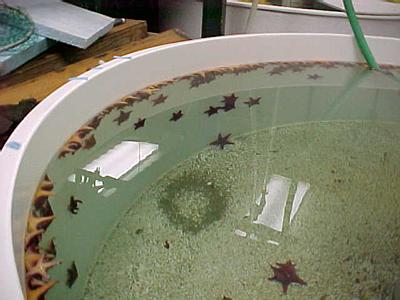
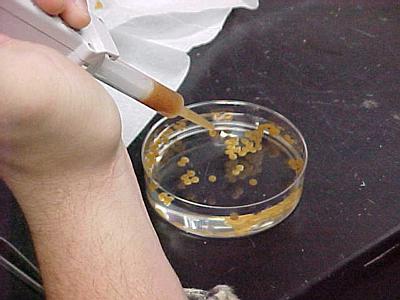
Dropping pellet mixture into calcium chloride solution with pipette.

Cluster of brachiopods attached to a rock.
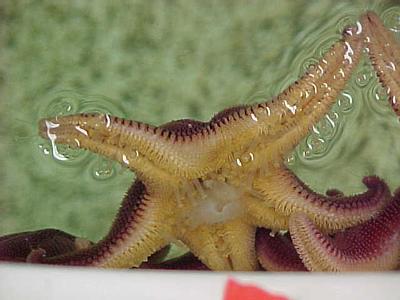
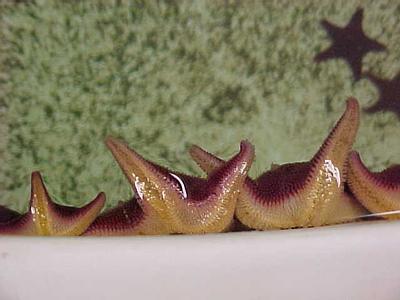
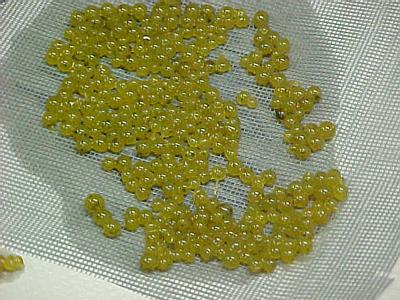
Finished bioassay pellets.

Contact the TEA in the field at
.
If you cannot connect through your browser, copy the
TEA's e-mail address in the "To:" line of
your favorite e-mail package.
|
